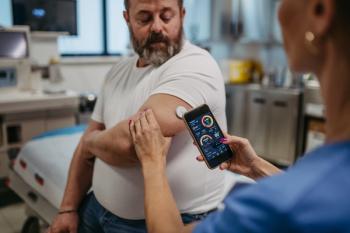
- February 2013 Autoimmune Disorders
- Volume 79
- Issue 2
Don't Share Insulin Pens Between Patients
Sterility is not maintained by putting a new needle on a used pen device.
Sterility is not maintained by putting a new needle on a used pen device.
A single insulin pen device is never suitable for use with multiple patients due to the risk of cross contamination and transmission of bloodborne diseases. Air bubbles and pathogenic contaminants can enter the cartridge after injection while the needle is still attached to the pen.1
In 2009, the Institute for Safe Medication Practices (ISMP) cooperated with the FDA on a Patient Safety News video (
An Illusion of Safety
Repeated event reports suggest that there is an alarming and widespread misunderstanding that sterility can be maintained between patients by affixing a fresh needle on a pen device. An incident in 2010 in Wisconsin required notification of more than 2000 potentially exposed patients due to inappropriate sharing of insulin demonstration pens used during patient training. Two reports submitted to the ISMP National Medication Errors Reporting Program describe nurses knowingly using the same insulin pen for multiple patients. Both nurses thought the practice was acceptable because they changed the needle between patients. In one case, it was later determined that the original patient had HIV. Followup exposure treatment and testing were being conducted on the affected patient.
According to the Centers for Disease Control and Prevention (CDC), evidence continues to mount that this dangerous practice is still affecting thousands of patients (
Safeguarding Patients
Health care practitioners must be aware and educate patients that insulin pens are meant for use on a single person only, and should never be shared with others, even when the needle is changed. Likewise, pen needles and fingerstick devices should not be reused on the same patient or shared with others. This should be explained to all patients by prescribers and pharmacists when patients receive a prescription for or are dispensed an insulin pen.
In acute care, long-term care, and group home/residential settings, insulin pens should be assigned to individual patients and labeled accordingly. Space is lacking on the pen for application of a patient label, so pharmacists must affix a “flag” label, taking care to attach the label to the body of the pen, not the cap, without covering the drug name. If the label is on the cap, once the cap is removed, the pen is no longer labeled for a specific person.
Timely staff education and ongoing monitoring is critical to assuring safe use of insulin pens. Long-term care facilities may find education and monitoring difficult to accomplish due to staff turnover and time constraints, but this should not hinder them from collaborating with their pharmacy providers to determine how often educational programs must be conducted and to consider other safeguards to put in place.
Insulin demonstration pens, which typically contain saline solution, are used to teach patients dosing and administration technique. However, they are NOT intended to be used on patients. Patients should practice administering the dose by injecting the saline solution into an orange.
Please keep in mind that other medications (eg, exenatide, teriparatide)—not just insulin—are available in pen injectors. These devices carry similar risks of cross contamination and transmission of blood-borne diseases when shared among patients. The safe practice recommendations above should be applied to all pen injector devices.
Dr. Gaunt is a medication safety analyst and the editor of ISMP Medication Safety Alert! Community/Ambulatory Care Edition.
References:
- Sonoki K, Yoshinari M, Iwase M, et al. Regurgitation of blood into insulin cartridges in the pen-like injectors. Diabetes Care. 2001;24(3):603-604. http://care.diabetesjournals.org/cgi/content/full/24/3/603.
Articles in this issue
almost 13 years ago
New Drugs of 2012, Part 1almost 13 years ago
My Best Day as a Pharmacist: The Runners-Upalmost 13 years ago
Case Studiesalmost 13 years ago
Can You Read These Rxs?almost 13 years ago
To Increase Use, Address Preconceptions About Generic Drugsalmost 13 years ago
They Asked for it: Patient Request Fuels Brand-Name Preferencealmost 13 years ago
GPhA Reacts to FTC Report Critical of Pay-to-Delay Agreementsalmost 13 years ago
Pet Peevesalmost 13 years ago
Health App Wrapalmost 13 years ago
Pill Bottle Trackers: Will New Tech Tool Stay Legal?Newsletter
Stay informed on drug updates, treatment guidelines, and pharmacy practice trends—subscribe to Pharmacy Times for weekly clinical insights.


















































































































































































































